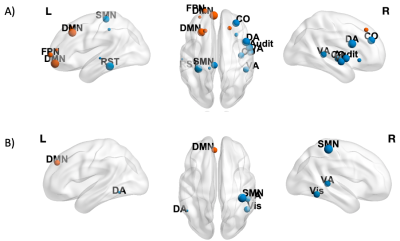Beatrice Federica Luciani1, Francesca Saviola1, Luca Zigiotto2,3, Stefano Tambalo1, Domenico Zacà1, Lisa Novello1, Silvio Sarubbo2,3, and Jorge Jovicich1
1CIMeC Center for Mind/Brain Sciences, University of Trento, Rovereto (Trento), Italy, 2Department of Neuroscience, Division of Neurosurgery, S.Chiara Hospital, APSS, Trento, Italy, 3Structural and Functional Connectivity Lab, S.Chiara Hospital, APSS, Trento, Italy
1CIMeC Center for Mind/Brain Sciences, University of Trento, Rovereto (Trento), Italy, 2Department of Neuroscience, Division of Neurosurgery, S.Chiara Hospital, APSS, Trento, Italy, 3Structural and Functional Connectivity Lab, S.Chiara Hospital, APSS, Trento, Italy
Left-lateralized gliomas and high-grade gliomas reduce longitudinal functional segregation and centrality after surgical resection. The Default Mode Network supports post-surgical plasticity, highlighting its relevance for pre-surgical planning.

Nodes showing a significant negative effect (β<0, p<0.05 FDR-corrected) of Time on CI (A) and BC (B) are shown in blue (non-hubs) and orange (hubs). Nodes are weighted for the statistical significance (p-value). For image display purposes, concerning CI, labels are plotted for most significant nodes (threshold 0.03).

Nodes showing a significant negative effect (β<0, p<0.05 FDR-corrected) of Time × Tumor grade on Cl in LGG patients are represented in blue (non-hubs) and orange (hubs). Nodes are weighted for the statistical significance (p-value). For image display purposes, concerning Cl, labels are plotted for most significant nodes (threshold 0.03).
